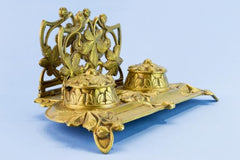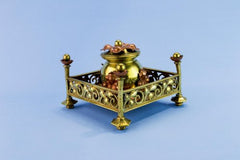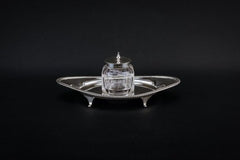Inkwells – a Trip to the Pre Smartphone Era

In the 1950s US Post Office has scrapped the use of dip pens and inkwells in all its branches across America and replaced them with new roller ball pens. This indicated one of the major and final steps in the global shift from a nib and ink based writing to a modern ball penmanship. The imminent change has been there for about a century, since the appearance of the first practically usable fountain pen in the mid-19th century. However, even then most of the writing carried on to be done with the steel nib straight pens dipped in inkwells.


Glass was the most common material for inkwell production since the late Georgian period, the early 1800’s. However, many inkwells were also made of ceramics, notably the waterproof porcelain or glazed slipware pottery; stone, wood, metals, very commonly brass but also silver and gold, and many other materials. Among the widely collected inkwells are those dating from the 19thcentury. But many 18th century examples do appear on the market, while they tend to be of a grander appearance. Homemade inkwells are also popular with the today’s collectors, as they are often uniquely designed and employ a variety of unusual materials and making techniques.


Some of the finest glass inkwells of the early 19th century were produced in blown three part molds. As it describes – the glass was blown into a mold made of three parts. Such glass products can be easily recognised by the rough unpolished seams running on their external surface. The molds were carved with intricate patterns and decorations and they often followed the contemporary cut glass designs. The glass varied from colourless translucent to Ruby red, Bristol blue, milky opaque, Cranberry, yellow and other colours. The most sought after inkwells are those having the most intricate patterns and unusual colours. These often fetch hundreds of pounds at auctions and are fought over by international enthusiasts.

Victorian and later inkwells are still relatively modestly priced and affordable for the beginning collector. In the industrial age these were often machine cut decoration pieces, but molded and pressed glass pieces were also in production. Late 19th century pieces start featuring attempts at producing art glass of various colours.
Metal inkwells were pricier to make than their glass counterparts, although brass molds were fairly mass produced. Some Berlin iron and Vienna cold painted bronze inkwells, which often include figural or intricate architectural decorations, are exceptionally sought after pieces. And among the named designers Louis Comfort Tiffany and Lalique hold the high levels in terms of prices achieved in this field.
Therefore, my advice would be to look out for these seemingly useless items, they do tend to be good investments.




